Last updated: October 26, 2020
Article
Walk in the Footsteps of Suffragists
Learn about the places associated with the spectacular pre-inauguration parade that filled Pennsylvania Avenue in Washington, DC with over 5,000 women, colorful floats and banners, ladies on horseback, and mayhem delivered by opposing forces.[1]
Visiting all of these sites will take you on a 1.3 mile walk. Please be aware of your surroundings and follow all laws.
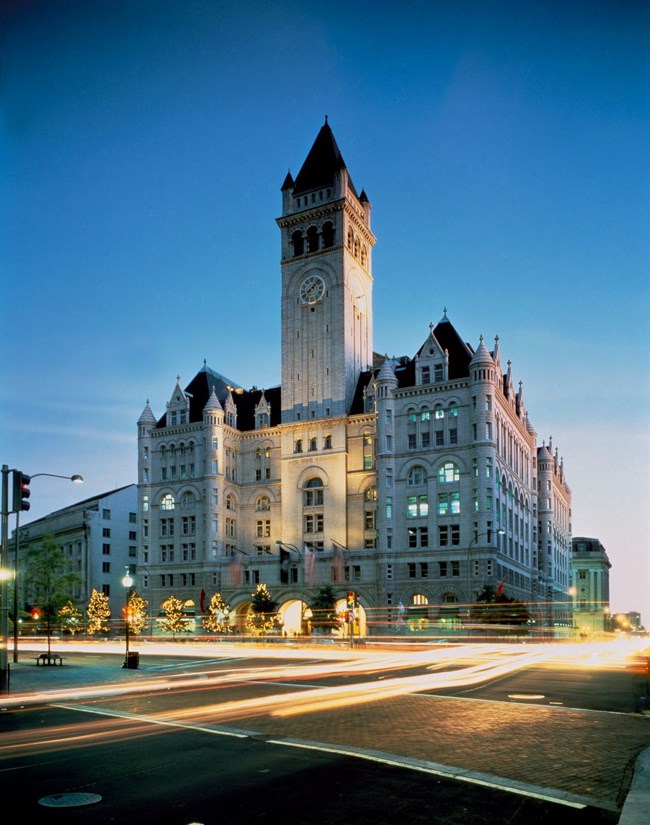
Collections of the Library of Congress (https://www.loc.gov/item/2011630731/)
The Old Post Office
Location: Intersection of 12th Street and Pennsylvania Avenue NW, in the area known as the Federal Triangle.[2] The NPS gives tours of the Old Post Office Tower.
The Old Post Office was completed in 1899, and is among the tallest buildings in DC. In the tower are the Congress Bells, a bicentennial gift from England. They are rung every Thursday evening and on special occasions.
From the Old Post Office Tower, you can look along Pennsylvania Avenue towards the Capitol Building. This is the route of the 1913 Suffrage Procession.
One of the founding principles of the United States is that all men are created equal. But many people, including women, did not have equal rights. Many women believed that the only way to address these inequalities was for women to vote. Women of all backgrounds demanded and campaigned for the vote in a variety of ways and at local, state, and national levels.
In 1913, a group of women led by Alice Paul organized a national Woman Suffrage Procession. It was held on March 3, 1913 -- the day before president-elect Woodrow Wilson's inauguration. Over 5,000 women marched; over 100 of them ended up in hospital.
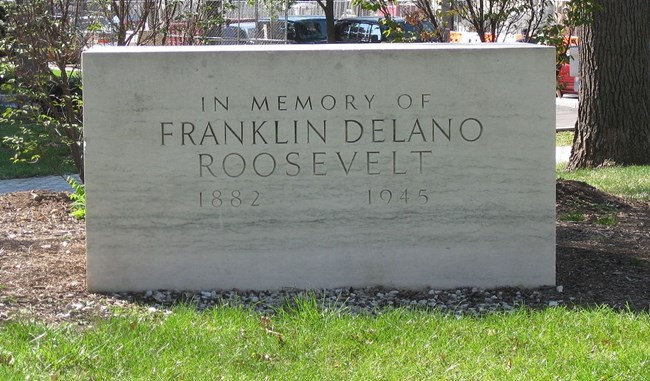
Photo by Nick-D, CC BY-SA 3.0 (https://commons.wikimedia.org/wiki/File:Original_FDR_memorial_Oct_09.JPG)
Original Franklin Delano Roosevelt Memorial
Location: On the corner of 9th Street and Pennsylvania Avenue, on the grounds of the National Archives and across the street from the Department of Justice.The white marble memorial was dedicated on April 12, 1965, marking the 20th anniversary of FDR's death. The form and location of the memorial was requested by FDR himself "If they are to put up any memorial to me, I whould like it to be placed in the center of that green plot in front of the Archives Building. I should like it to consist of a block about the size [of a desk]." A larger memorial to FDR is located on the National Mall.

Photo courtesy of the DC Public Library (https://www.flickr.com/photos/dcplcommons/4225800921/)
The march drew an estimated 250,000 onlookers. For several city blocks, from 4th Street through 10th and 12th Streets, the crowd swarmed the marchers. The onlookers were not all friendly. As they forced the suffragists to march in single file, they yelled insults: "If my wife were where you are I'd break her head." Even some of the police were unfriendly, yelling "This is the best looking bunch of suffragettes I ever saw," and "Stop pushing!" (said imitating a woman's voice while making no effort to stop the pushing). Over 100 marchers were hospitalized.
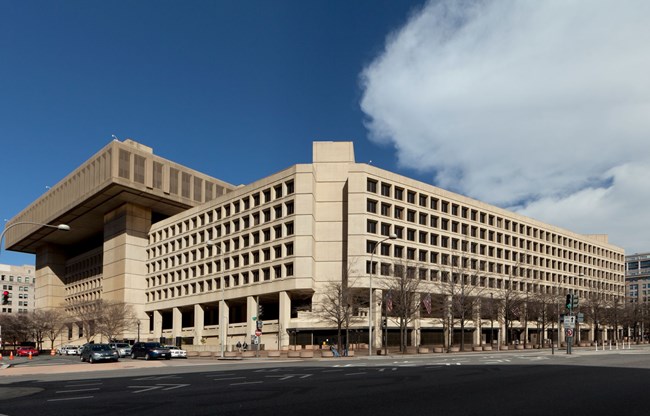
Collections of the Library of Congress (https://www.loc.gov/item/2013634628/)
J. Edgar Hoover Building (FBI Headquarters)
Location: 935 Pennsylvania Avenue. There is a museum you can tour, but you must request access well in advance.This building was finished in 1975, and was not present when the suffragists marched along Pennsylvania Avenue. But there is a connection!
The headquarters of the Federal Bureau of Investigation (FBI) is named for J. Edgar Hoover. He served as the first Director of the Federal Bureau of Investigation from July 1, 1935 to May 2, 1972. Much earlier in his life, during his high school participation on the debate team for DC's Central High School, Hoover argued against women's access to the vote.[3]
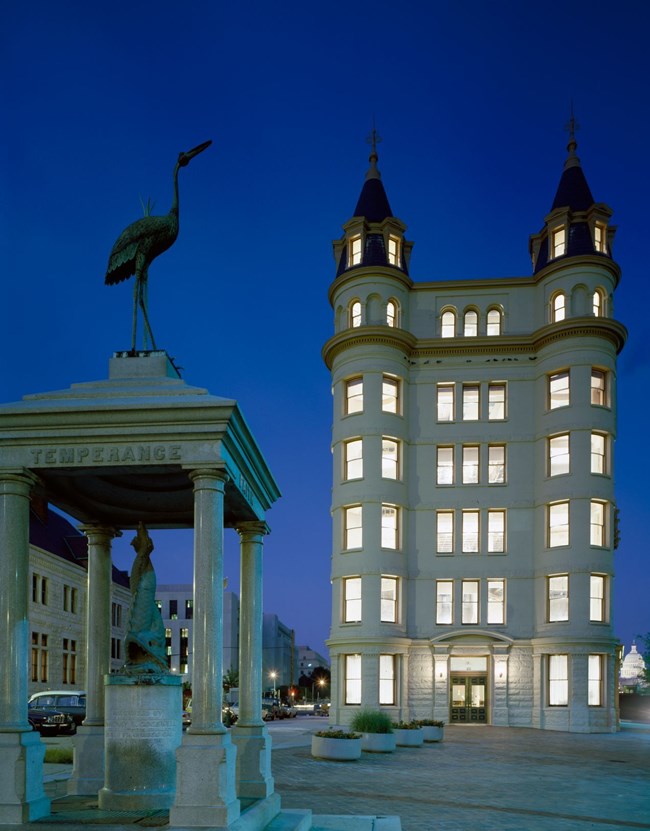
Collections of the Library of Congress (https://www.loc.gov/item/2011632015/)
Temperance Fountain
Location: Corner of 7th Street and Indiana Avenue NW (just off of Pennsylvania Avenue).Built in 1884 by Henry D. Cogswell, the Temperance Fountain was originally at 7th Street and Pennsylvania Avenue.[4] It was moved in 1987.
Temperance fountains were built to encourage the public to drink water, not alcohol, by providing cold, fresh water to drink. Before the city disconnected the water pipes from the Temperance Fountain in DC, drinking water flowed from the dolphin's snouts and collected below in a trough for horses.
Many of the people working for women's suffrage also worked in other social movements, including the abolition of slavery and the temperance movement.
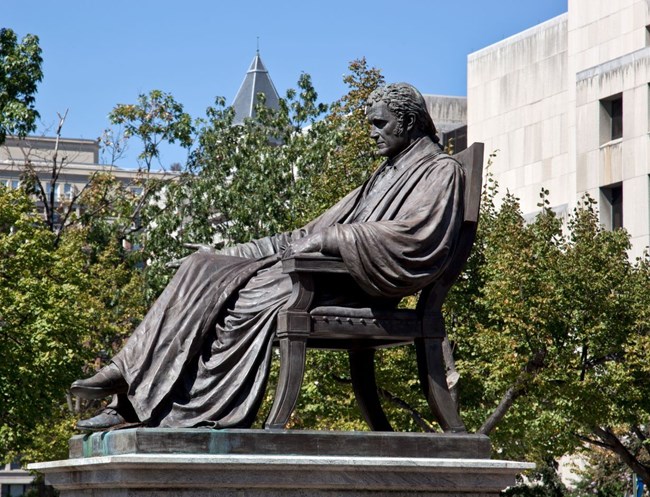
Collections of the Library of Congress (https://www.loc.gov/item/2010641731/)
John Marshall Park
Location: Across Pennsylvania Avenue from 4th Street NW.John Marshall was Chief Justice of the Supreme Court from 1801 to 1835.
The first woman jailed for voting was Susan B. Anthony in 1872. At the time, suffragists believed that the recently-adopted 14th Amendment gave them the right to vote. The 14th Amendment was one of the Reconstruction Amendments passed after the Civil War. It addressed citizenship and equal protection under the law in response to concerns of those who were formerly enslaved. In part, it reads:
The role of the 14th Amendment in giving women access to the vote was tested in the courts by Virginia Minor of St. Louis, Missouri. The case was first heard in the Courthouse in what is now Gateway Arch National Park. In 1875, the Supreme Court ruled in Minor v. Happersett that the US Constitution did not grant women the right to vote. In response to this ruling, suffragists turned to chaging the laws at state and national levels.

Collection of the Library of Congress (https://www.loc.gov/item/2010641995/)
Peace Monument
Location: On the grounds of the Capitol Building in Peace Circle at First Street and Pennsylvania Avenue, NW.The Peace Monument is also known as the Naval Monument or the Civil War Sailors Monument.[5]
The monument was sculpted by Franklin Simmons. The women at the top of the monument represent Grief and History. History holds a tablet reading, "They died that their country might live." Other female figures are Peace and Victory. They are accompanied by male figures representing Mars (god of war) and Neptune (god of the sea).
The 1913 Woman Suffrage Procession began near here, before continuing along Pennsylvania Avenue towards the White House.
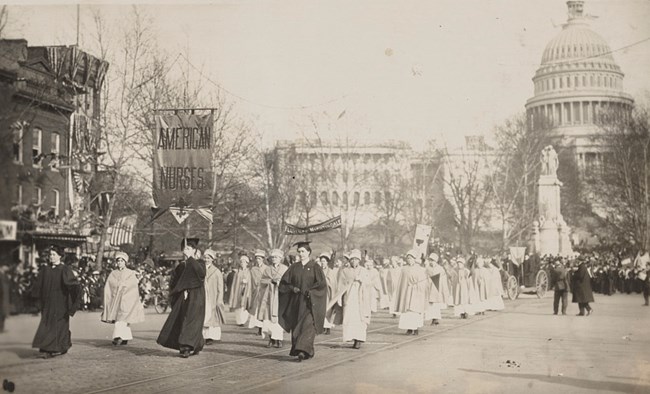
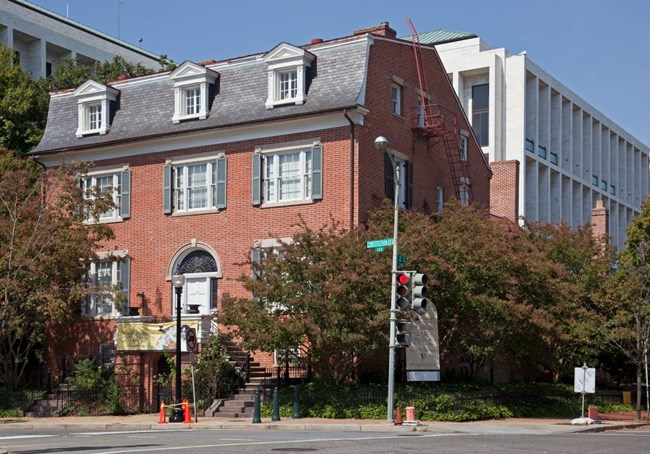
Courtesy of the Library of Congress (https://www.loc.gov/item/2010641663/).
Belmont-Paul Women's Equality National Monument
Location: Corner of Constitution Avenue and 2nd Street NE, next to the Hart Senate Office Building.Belmont-Paul Women's Equality National Monument was formerly known as the Sewall-Belmont House.[6] It has long been the headquarters of the National Woman's Party.
As well as organizing the 1913 Suffrage Procession in DC, the National Woman's Party also organized a picket of the White House to increase pressure on President Wilson. These "Silent Sentinels" stood outside the White House around the clock holding banners demanding the vote. This was the first time that the White House had been picketed as a form of protest.
When World War I started, public sentiment turned against the women. They should not, people thought, be protesting the President in a time of war. Several of the women were arrested and jailed. One night, known as the "Night of Terror," they were beaten and brutalized. When some of them went on a hunger strike at Occoquan Workhouse, they were forcefed.[7] When the public found out about the violence, it helped change public opinion in support of suffrage. In 1919, Congress passed the 19th Amendment and it was up to the states to ratify.
In August 2020, Tennessee was the last state needed to ratify the Amendment and it was signed into law. After passage, the National Woman's Party shifted their work to the Equal Rights Amendment, which has not yet become law.
[1] Pennsylvania Avenue National Historic Site (Washington, DC) was established on September 30, 1965 and added to the National Register of Historic Places on October 15, 1966. Pennsylvania Avenue running from the US Capitol to the White House forms the heart of the Historic Site. It extends outwards to include Constitution Avenue and portions of G Street NW.
[2] The Old Post Office and Clock Tower is part of the Pennsylvania Avenue National Historic Site. It was added to the National Register of Historic Places on April 11, 1983.
[3] Central High School at 13th and Clifton Streets, NW (now known as Francis L. Cardozo Senior High School) was listed on the National Register of Historic Places on September 30, 1993.
[4] The Cogswell Temperance Fountain in Washington, DC was listed on the National Register of Historic Places on October 12, 2007.
[5] The Peace Monument was added to the National Register of Historic Places on September 20, 1978.
[6] The Sewall-Belmont House was added to the National Register of Historic Places on June 16, 1972 and designated a National Historic Landmark on Mary 30, 1974. It was designated the Belmont-Paul Women's Equality National Monument in 2016.
[7] Occoquan Workhouse is part of the DC Workhouse and Reformatory Historic District in Lorton, Virginia. It was added to the National Register of Historic Places on February 16, 2006.
Sources:
Adiletta, Dawn. Elizabeth Cady Stanton: Women's Suffrage and the First Vote. Rosen Publishing Group, 2005
Jones, Wesley L. (Chair). Suffrage Parade. Hearings before a subcommittee of the Committee on the District of Columbia, United States Senate, Sixty-third Congress, special session of the Senate, under S. Res. 499, of March 4, 1913, directing said committee to investigate the conduct of the District police and Police department of the District of Columbia in connection with the woman's suffrage parade on March 3, 1913... Online at the Hathi Trust.
Lunardini, Christine. Alice Paul, Equality For Women. Westview Press, 2013.
Tags
- belmont-paul women's equality national monument
- franklin delano roosevelt memorial
- gateway arch national park
- national mall and memorial parks
- pennsylvania avenue
- the white house and president's park
- women's rights national historical park
- washington d.c.
- women's history
- 19th amendment
- walking tour
- civil rights
- national mall and memorial parks
- suffrage
- belmont-paul
- pennsylvania avenue
